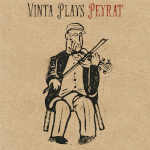
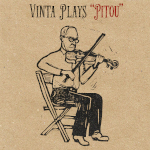

Vinta is an Ontario-based group with a wide repertoire of sounds and styles, which has inspired them to produce an excellent series of short albums - or long EPs - each featuring one of their musical icons. So far nine of these tribute albums are released, all available at www.vinta.bandcamp.com, and they pay hommage to musicians both familiar and unfamiliar. Oldtime, European, Quebecois and more, this collection is full of rare and exhilarating music. Vinta combines Emilyn Stam on fiddles and accordion, John David Williams on clarinets and accordion, Nathan Smith on fiddles, and Robert Alan Mackie on double bass.
The growling rhythmic tunes of Leon Peyrat from the borders of Limousin and the Massif Central are a fine example of the French fiddle tradition, played for dancing, but sadly almost lost with the arrival of the accordion and the need for louder instruments in the Paris dancehalls at the end of the 19th century. Peyrat was one of a very small number of fiddlers in south western France in the 1900s, and although he was featured in two documentary films his music is little known outside the Limousin region. Fortunately the fiddle tradition in France has picked up in recent years, starting before Peyrat's death in 1988, but there are still very few recordings. This selection includes the distinctive polkas, marches, mazurkas, waltzes and bourrees of Peyrat.
Similar in many ways to Peyrat, the fiddling of Louis "Pitou" Boudreault is in the classic French Canadian style - designed for dancing, with added rhythm from the musicians' feet. Pitou was an almost exact contemporary of Peyrat, born a year later in 1905 and dying in 1988. Vinta's tribute starts with the well-known crooked reel Le Batteux, mimicking the beat of the old threshing machines. Four reels form the bulk of this short selection, but there's great variety in the instrumentation: Reel à Cédulie is led by Williams on clarinet, and the solidly 4/4 Gigue à Célina brings in strong harmonica, still an important instrument in Quebec today. The final slow march La Pêcheuse starts on bowed bass I think, switching to fiddle, then to clarinet, and building to an elegant finish with vocals reminiscent of more contemporary styles.
In fact, the modern taste for adding wordless vocals to instrumental melodies was well represented by Oliver Schroer, fiddler and multi-instrumentalist from Vancouver, who died in 2008 at the age of 52. Vinta's hommage to this prolific composer and exciting performer is upbeat, jazzy, happy and life-affirming as Oliver's music almost always was. These eight pieces are all Schroer's own compositions, I believe, whereas the other albums in this series are mostly traditional pieces first written or recorded by the iconic musicians whose repertoires Vinta has chosen to feature. Old Soul is the only tune here which doesn't bring a sile to my face. Driftwood Canyon Waltz is a nice example of new tunes in the oldtime tradition: wile it owes something to the Napoleonic song Warlike Lads of Russia it makes enough changes and adds a delightful second part to produce a fine original work.
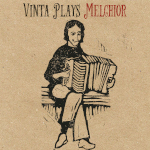
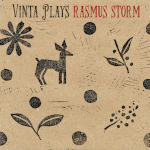
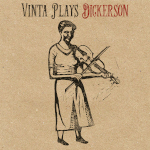
It's not all fiddlers. Elisabeth Melchior (1926-1999) was a melodeon player from Belgium, born in Walk which is near the borders with Germany, Luxembourg and the Netherlands, so although Melchior probably spoke French or at least the Walloon dialect, she would have absorbed music from the Germanic traditions as well. Her tunes are well documented, at least in Belgium, and she did tour the USA in the 1970s, but her music is not heard much beyond her own country today. The four selections played by Vinta, led on accordion, seem to lean towards Flemish or Dutch music rather than the French tradition: schottisches, polkas, a mazurka and a waltz, punchy and perfect for dancing, with a bit of melodeon oompah behind each tune.
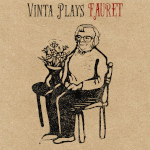
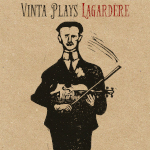
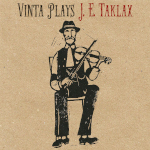
The album Vinta plays Fauret is an interesting one, based on a more traditional use of vocals for dance music. Mme Simone Fauret (1924-2018) kept a cafe in the Auvergne region of France, and although she played no instrument she had a good voice and contributed many tunes to recordings made by folklore collectors. Mazurkas, bourrees, polkas and schottisches from her repertoire are all represented here, with imaginative arrangements which suggest how the instrumental versions may have sounded. The final schottische is particularly lovely.
The music of Rasmus Storm is rather different. Born in 1733, this Danish master fiddler comes from a period where classical and folk music were still inextricably entwined, and in Denmark everything was written down by hand in the same book by the local fiddler. Storm's book contains at least 60 pieces, of which six are performed by Vinta here: a polka, two marches, and three graceful minuets with some lovely bass clarinet on the last one. The arrangements are suitably formal, but still fun and very danceable.
French fiddler Marcel Lagardère brings the Gascon rondeau to the list of dances here. Another fiddler from the early 20th century, his music emphasises rhythm, getting maximum volume from the fiddle in order to be heard by the dancers. The similarities to American oldtime are striking - simple melodies with strong harmonies. Vinta have chosen less well known tunes for this tribute, a nice change as many French tunes share the same roots across different regions: these pieces may be true specialités de la region!
If it's oldtime you're after, you could fork a lot of hay before you found anything better than Emma Lee Dickerson. This short burst of Dickerson tunes includes favourites like Liza Jane and Susan's Gone, as well as rarer gems such as Texas John, all played in Dickerson's pre-Bluegrass Kentucky style. Driving down-home rhythms are combined with virtuosic performances for the competition platform.
I've deliberately kept the music of Johan Erik Taklax (1856-1948) to last. This Finnish-Swedish fiddler has passed on many polskas in the Finnish tradition, and four of them are reprised by Vinta in this collection. As is usual in Swedish music, each is simply named Polska efter J E Taklax in a particular key - G, A, D minor and G minor here. The pieces are not particularly complex - it seems Taklax was more of a village fiddler, playing for dances, than a concert performer or competition virtuoso. His tunes have been recorded by many fine contemporary Finnish musicians, and Vinta's arrangements show how enjoyable this old Finnish music can be.
From France to Finland, Kentucky to Quebec, Vinta's tastes are broad and they have chosen excellent examples from each tradition. Spanning four centuries and two continents, this collection of tribute mini-albums is an excellent supplement to Vinta's full-length CD Beacons which combines many of these influences. All these recordings are available for download at a reasonable price from Bandcamp.
Photo Credits:
(1ff) Vinta
(unknown/website).